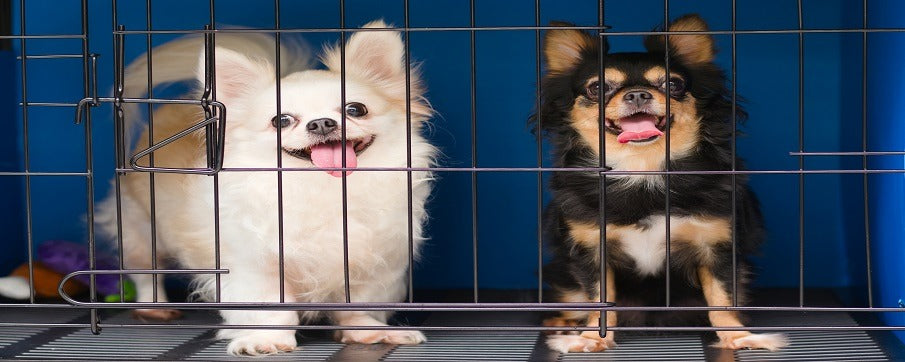
How Big Should Puppy Crate Be?
Posted on
Purchasing a crate is an investment in your puppy and your future life as a happy dog owner. Crate training is extremely beneficial, and you will reap the rewards of your early efforts over the years with your dog. Crate training provides your dog with a safe and secure plan to call his own. It gives him somewhere he can be shut down and can't cause damage if left alone. It can be beneficial in a busy household if your dog feels overwhelmed by visitors. If you are travelling or staying away, bringing your crate with you will give your dog a feeling of security, even if you are in an unfamiliar place. So, choosing the right size dog's crate is important, but remember, puppies grow!
Why Does Your Dog's Crate Size Matter?
It may not be that important, but it is. To create a safe and secure environment for your dog, the crate must be the right size. Dogs will relax when they feel safe. If you watch where a dog naturally chooses to sleep, it will often be in a corner or tucked away so that it feels protected. Too large or too small, and your dog won’t be happy and relaxed in his crate.
Considerations for Choosing Dog Crates
If you are buying a crate for your puppy, remember that they grow! Not only this, but all breeds grow proportionately to a different extent. A tiny toy breed like a Chihuahua will grow, but the size difference is not as dramatic as a giant breed. A Newfoundland puppy starts relatively small and then just keeps growing! So you need to keep all of this in mind when choosing a puppy's crate size, such as the initial size of the puppy compared with its fully grown size, given its breed. Even within a breed, there is variation between each dog, as well as size variations between dogs and bitches. Owning an array of different-sized crates can be beneficial if you have many dogs, as a well-made dog crate will last for years. If you have a breed of puppies that will grow substantially, it is best to start with a smaller crate and upgrade to a larger one as he grows. You could put a crate divider inside your crate to reduce the size of a large crate as another alternative.
How to Measure for the Proper Dog Crate Size
If you are choosing a crate for your puppy that is intended to last into his adult years, then you need to go by the breed standard for your dog. If you choose a crate for a fully grown dog, this part is simple! Your dog needs a crate high enough to stand up without having to duck his head. Consider that some dogs carry their head very high, so measure to the top of the head, not just to the shoulder. He should be able to comfortably turn around without bashing himself on the sides, and he should be able to lie down with his legs stretched out. It is worth measuring the length and height of your dog to give you a starting point for calculating the best crate for your dog. If you have a puppy, then the breed standards should give you an indication of size. If you buy your puppy from a reputable breeder, ask them what size crate they use for their dogs, as this would give you a good guide.
Why Is It Important to Have the Right Dog Crate Size?
You want your dog to feel safe and secure in his crate, which comes down to choosing the right-sized crate. A good-sized dog crate will help house-train your puppy and give you someone to pop him if you have visitors or if he is worn out. It will make it easier to take your dog to other places, to travel, and in an emergency. A crate is an invaluable resource at your disposal, and it is worth investing in a good-quality crate that is the right size.
Common Mistakes to Avoid
If a crate is too big, your dog won't gain the sense of security it needs. If you are using your crate for house training with your puppy, then the size of the crate is also important. In general, a dog won't toilet where he sleeps, so if he perceives the whole crate as a bed, he is more likely to hold it in! If his bed is at one end, and there are masses of space at the other, he may see this as a convenient toileting area. Obviously, no one wants to be put inside a too small crate, so make sure you choose the right size crate.
Puppies Learn to Love Their Crates When You Make a Proper Space For Them
Crates are safe spaces; they must never be used for punishment. If you make a crate comfortable and inviting, your puppy will enjoy spending time in it and often choose to go there for his naps. Comfy bedding, a few crate-friendly toys, and access to fresh water will ensure your pet enjoys his crate time.
Where to Buy Your Puppy Crate?
As with all purchases, research and choose a well-made and sturdy crate for your dog. Whether buying your first puppy or adding another to your well-established pack, we help. Here at Dog Kennels Direct, we have a range of wire-meshed dog crates ideal for all sizes and dog breeds. You can take a look at our range, or if you want helpful and friendly advice about the best kenneling or crating solution for your dogs, then simply call our team on 01942 316 431
Read the related article:




